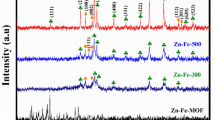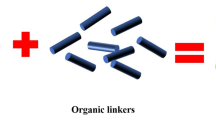Abstract
In this paper, we synthesize a needle-like polyoxometalates@Fe-based metal–organic framework (POM@Fe–MOFs) composites, in which the Keggin-type W-based POM with negative charges exist as secondary building units of Fe-based MOFs. Based on the synthesized POM@Fe–MOFs, WO2@FeWO4 is easily prepared by appropriate thermal treatment. On the one hand, the derivative retains the original POM@Fe–MOFs morphology. Owing to the face that the Fe element contains variable valence state and the W element in tungstophosphoric acid exists in the form of high valence, both of which have great potential in the field of electrochemistry. According to the systematical characterization, the results show that WO2@FeWO4 composite can be used as positive electrodes in supercapacitors which is reported for the first time. In addition, the WO2@FeWO4 is confirmed to exhibit an excellent capacity of 124 F g−1 at a current density of 0.5 A g−1 in 6 M KOH when used in supercapacitors, which can be attributed to the redox reaction of W element.








Similar content being viewed by others
References
M. Zhi, Effects of pore structure on performance of an activated-carbon supercapacitor electrode recycled from scrap waste tires. ACS Sustain. Chem. Eng. 2, 7 (2014)
L. Demarconnay, A symmetric carbon/carbon supercapacitor operating at 1.6 V by using a neutral aqueous solution. Electrochem. Commun. 12, 10 (2010)
Z. Xin, Enhanced specific surface area by hierarchical porous graphene aerogel/carbon foam for supercapacitor. J. Nanopart. Res. 19, 12 (2017)
J.J. Yoo, Ultrathin planar graphene supercapacitors. Nano Lett. 11, 4 (2011)
Z.J. Han, High-frequency supercapacitors based on doped carbon nanostructures. Carbon (2018). https://doi.org/10.1016/j.carbon.2017.10.014
X. He, All-solid state symmetric supercapacitors based on compressible and flexible free-standing 3D carbon nanotubes (CNTs)/poly (3, 4-ethylenedioxythiophene) (PEDOT) sponge electrodes. J. Power Sources (2018). https://doi.org/10.1016/j.jpowsour.2017.09.084
D.W. Wang, Hierarchical porous nickel oxide and carbon as electrode materials for asymmetric supercapacitor. J. Power Sources 185, 2 (2008)
B. Yuan, Graphene oxide/nickel oxide modified glassy carbon electrode for supercapacitor and nonenzymatic glucose sensor. Electrochim. Acta 88, 2 (2013)
C. Guan, Iron oxide-decorated carbon for supercapacitor anodes with ultrahigh energy density and outstanding cycling stability. ACS Nano 9, 5 (2015)
G.A. Snook, Conducting-polymer-based supercapacitor devices and electrodes. J. Power Sources 196, 1 (2011)
E. Frackowiak, Supercapacitors based on conducting polymers/nanotubes composites. J. Power Sources 153, 2 (2006)
B. Liu, Metal–organic framework (MOF) as a template for syntheses of nanoporous carbons as electrode materials for supercapacitor. Carbon 48, 2 (2010)
R.R. Salunkhe, Fabrication of symmetric supercapacitors based on MOF-derived nanoporous carbons. J. Mater. Chem. A 2, 46 (2014)
F. Meng, Porous Co3O4 materials prepared by solid-state thermolysis of a novel Co-MOF crystal and their superior energy storage performances for supercapacitors. J. Mater. Chem. A 1, 24 (2013)
S. Chen, Rational design and synthesis of Ni x Co3–xO4 nanoparticles derived from multivariate MOF-74 for supercapacitors. J. Mater. Chem. A 3, 40 (2015)
P. Wen, Design and synthesis of Ni-MOF/CNT composites and rGO/carbon nitride composites for an asymmetric supercapacitor with high energy and power density. J. Mater. Chem. A 3, 26 (2015)
S.J. Yang, Preparation and exceptional lithium anodic performance of porous carbon-coated ZnO quantum dots derived from a metal–organic framework. J. Am. Chem. Soc. 135, 20 (2013)
Y. Zhang, All-solid-state asymmetric supercapacitors based on ZnO quantum dots/carbon/CNT and porous N-doped carbon/CNT electrodes derived from a single ZIF-8/CNT template. J. Mater. Chem. A 4, 26 (2016)
J. Mu, Highly dispersed Fe3O4 nanosheets on one-dimensional carbon nanofibers: synthesis, formation mechanism, and electrochemical performance as supercapacitor electrode materials. Nanoscale 3, 12 (2011)
P.M. Kulal, Chemical synthesis of Fe2O3 thin films for supercapacitor application. J. Alloys Compd. 509, 5 (2011)
S. Li, An unprecedented 3D POM–MOF based on (7, 8)-connected twin Wells–Dawson clusters: synthesis, structure, electrocatalytic and photocatalytic properties. Dalton Trans. 44, 5 (2015)
Y. Zhang, MoO2@ Cu@ C composites prepared by using polyoxometalates@ metal-organic frameworks as template for all-solid-state flexible supercapacitor. Electrochim. Acta (2016). https://doi.org/10.1016/j.electacta.2015.12.037
Y. Zhang, Polyoxometalates@ metal-organic frameworks derived porous MoO3@CuO as electrodes for symmetric all-solid-state supercapacitor. Electrochim. Acta (2016). https://doi.org/10.1016/j.electacta.2016.01.161
P.A. Jalil, A study of the stability of tungstophosphoric acid, H3PW12O40, using synchrotron XPS, XANES, hexane cracking, XRD, and IR spectroscopy. J. Catal. (2003). https://doi.org/10.1016/S0021-9517(03)00066-6
S. Bordiga, Electronic and vibrational properties of a MOF-5 metal–organic framework: ZnO quantum dot behavior. Chem. Commun. (2004). https://doi.org/10.1039/B407246D
L. Hu, Deposition of CdS nanoparticles on MIL-53 (Fe) metal-organic framework with enhanced photocatalytic degradation of RhB under visible light irradiation. Appl. Surf. Sci. (2017). https://doi.org/10.1016/j.apsusc.2017.03.140
Acknowledgements
This work was financially supported by the National Natural Science Foundation of China (61604110), China Postdoctoral Science Foundation (2015M572210, 2016M602376), Natural Science Foundation of Hubei Provincial, China (2018CFC796, 2017CFC829, 2017CFB291), Department of Education Science Research Program of Hubei Province (Q20161110), and Open Foundation of Key Laboratory of Green Chemical Process (Wuhan Institute of Technology), Ministry of Education (NRGCT201503), Training Programs of Innovation and Entrepreneurship for Undergraduates of Province (201510488022), Guidance project of scientific research plan of Hubei Provincial Department of Education (B2017014), Key Projects of Scientific Research Program of Hubei Provincial Department of Education (D20171505).
Author information
Authors and Affiliations
Corresponding author
Rights and permissions
About this article
Cite this article
Zhang, W., He, X., Zhao, L. et al. A novel WO2@FeWO4 composite derived from polyoxometalates@Fe–metal–organic frameworks and its electrochemical properties. J Mater Sci: Mater Electron 29, 14612–14619 (2018). https://doi.org/10.1007/s10854-018-9597-8
Received:
Accepted:
Published:
Issue Date:
DOI: https://doi.org/10.1007/s10854-018-9597-8




